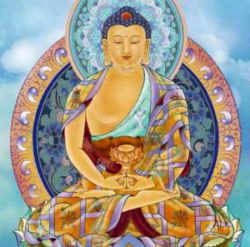The Buddha’s Age and Soon After
The time of the Buddha, c. sixth–fifth centuries B.C.E., was a time of social change and trade in India. Cities had developed and became places where wealth accumulated. Iron tools were widely used. A variety of social systems, including experiments with democracy as well as dictatorships, were tried. Slavery was a fact, as was the caste system, but the caste system was on the decline. The monetary system existed but was weak. Guilds were also weak. The most important development was the
merchant class, the members of which were readily attracted to the new system of thought. The Buddha’s teachings offered an alternative to Brahmanism, the traditional belief system dominated by the Brahman, or priestly, caste. The Buddha was born in the Sakya city of Kapilavastu. There is disagreement about where that site is today: one version is in southern Nepal, at Tilaurakot, Padaria. Another version, based on recent archaeological work, suggests Piprahwa in present-day India. Although surrounded by luxury, the young prince Siddhartha was dissatisfied, and at the age of
29 he left home to seek answers to the questions of existence. After wandering for six years he achieved enlightenment at Buddhagaya, under a Bodhi tree. He at first did not wish to teach his conclusions, but, persuaded to do so by the brahman Sahamapati, he relented and decided to preach. The Buddha’s first sermon was given at Benares, at Migadaya, where he explained the Four Noble Truths. Indeed the Buddha was one leader among several heterodox (nonconformist) leaders, a group that included Nigantha Nataputta, founder of the Jain religion, which has continued to this day. Like many such leaders, the Buddha repudiated many of the religious assumptions of his time. He
did not accept the Vedas as being infallible sources of truth. Nor did he put great importance in ritual. He did not accept the caste system, which rigidly categorized people, and he was especially critical of the Brahmanic classes. He advocated personal discipline but not extreme asceticism. His teachings were in this sense more an ethical code than a ritual practice. In all things the individual was urged to think matters through and make his or her own decisions. On the other hand, Buddhism retained many indigenous teachings from India, including the notion of samsara, the
recurring cycle of the world, and karma, the notion that one builds up debts through deeds. He also accepted the widespread practice of the religious community remaining separate from society. The Buddha was active for another 45 years, teaching in such urban centers as Rajagrha, Sravasti, and Vaisali. It was at Vaisali that the Buddha ate food offered by Cunda, a blacksmith, and passed away. In Buddhist writings this event is not called his death but his parinirvana, because an enlightened being has no possibility of a mortal death. India was later unified under the Mauryan dynasty 317–180 B.C.E., and the rule of Asoka (c. 282–232 B.C.E.) was crucial in spreading Buddhist practice. Asoka established a centralized state and erected highways and canals. His edicts were often carved on rocks or pillars. Buddhist beliefs were also promoted by craftsmen and merchants, as well as members of the Sangha, the Buddhist order of monks. Also during the Mauryan period large structures such as the stupa at Sanci and stone caitya (shrines) were built to honor the Buddha. Asoka is thus closely associated with this first stage of Buddhism’s development.
